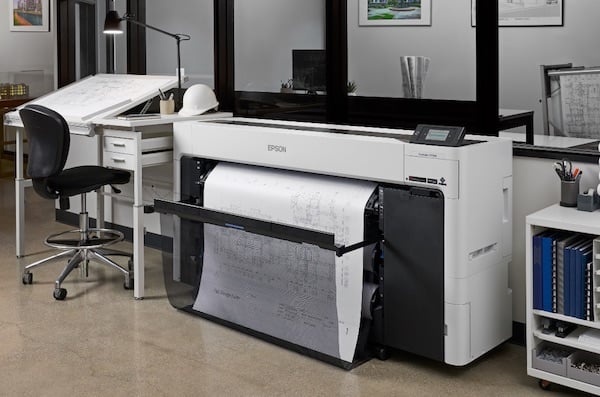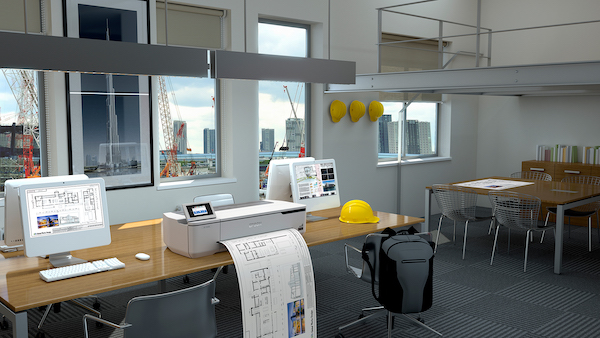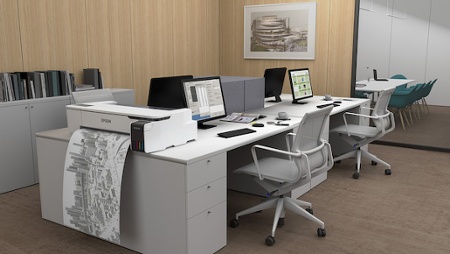
The Epson SureColor T-Series offers designers in-house print options, including ease-of use, time savings, and control of all print-jobs. Image source: EPSON
Businesses today depend on an essential combination of print and digital files, a key component of optimizing day-to-day workflow efficiency. While outsourcing print jobs may seem like an easier process for some organizations, it’s not a perfect solution. Some critical challenges can include experiencing delays and lag time, losing control of results, and facing higher costs.
Investing in printing equipment with robust functionality used to be a significant investment. However, advances in printing technology have led to more cost-effective, reliable, and accessible options for an array of businesses. From convenience to long-term cost of ownership, there are numerous things to consider when looking at in-house versus outsourcing printing needs and advantages for bringing printing capabilities in-house.
Efficiency and Convenience
While some businesses may decide to outsource printing to maintain lower, upfront equipment costs, outsourcing print jobs can add significant time, hassle, and potential logistical issues to the process. This is especially challenging (and frustrating) when working with tight deadlines — employees may need to take extra time to transport files themselves or rely on mail services and spend on shipping or processing fees.
Using dedicated, in-house printing equipment, team members can print content as needed, on the spot. Printing multiple drafts, mockups and samples on the same day to review with the whole team can be a lot easier than picking certain documents to print and waiting for jobs to be complete. With in-house printing, turnaround times are much shorter, and it’s easy for businesses to print both large volumes of reoccurring and ongoing jobs as well as custom, specialty projects. Customization allows businesses to change and personalize messaging and content for every print to meet different needs, so it’s easy to create one print for a client, and a similar print for in-house use.
Greater Flexibility
Editing and revision between team members is a significant part of workflow processes. When print jobs are outsourced, employees are oftentimes stuck waiting for updates and results, and there are additional changes made before receiving the updated prints. The ability to develop, design, print, and review content directly gives businesses the flexibility to see results in real-time and quickly make changes, when needed.
In addition, modern wide-format printers also present a wide variety of opportunities for businesses to print. From technical drawings and blueprints to maps and posters, advanced printers today deliver client-ready results with precision and speed at an economical cost. Businesses can take advantage of industry-leading printhead technology, advanced connectivity, outstanding image quality — all in a compact design — without having to utilize a third-party provider that often requires additional time and coordination.
Greater Control
While outsourcing different functions can help provide businesses with additional resources for a fixed period of time, turnaround times for printing can be several days and dependent on factors out of your control.
Investing in your own equipment and having an in-house printer means that team members can create and produce printed materials within a few minutes or hours. Managing print files directly can provide you with greater authority over your schedule, costs and needs. In addition, with greater control of the print queue and priorities, team members can easily decide which documents to print first and manage client and internal team requests on a day-to-day basis without a lag time. This is ideal for meeting fast paced deadlines, or making last minute changes prior to a new client pitch or board meeting.
Consistent High Quality
It’s important to ensure that all prints are high-quality, no banding, and brand colors stay consistent across all materials. When outsourcing print jobs to third-party providers, especially across multiple vendors, there may be instances of color discrepancies or other errors, as some equipment can deliver colors that vary widely from device to device.
Leveraging an in-house printer can help reduce the possibility that printing instructions are misinterpreted, and ensures that brand colors, messaging and overall quality is consistent and accurate. You control each print job, which is especially important with files that contain specific details, variable data, embargoed information, or multiple, different versions. Many advanced printers today come equipped with innovative ink technology to help deliver reliable color consistency and high image quality across all print jobs.
Managing Costs in the Long Run
Having to run out to third-party print vendors every time the team needs hard copies of wide-format documents not only wastes time but can also be very expensive. In many cases, you’re required to order a large quantity to get a lower price per page, or meet their required sizing requirements.
While bringing printing in-house may sound like a demanding and costly process for some businesses, it can help increase ROI. By prioritizing routine maintenance and investing in robust wide-format equipment supported by the manufacturer with warranty and service plans, businesses have the capability to print at any size, when they need it, and deliver high-quality results for the long term.
In today’s competitive marketplace, staying agile is essential. While there may be some benefits to outsourcing your printing, it can be inconvenient, time-consuming, and costly. Whether you’re working in architecture, engineering, construction, or CAD design, the ability to quickly produce technical drawings, blueprints, designs, and other documents is critical for maximizing productivity and staying efficient.
***
Viewpoint articles are tech-focused editorial written by experts from the CAD industry. This article was written by Jacob Hardin from Epson.
Jacob Hardin
Jacob Hardin is a product manager for Professional Imaging Division at Epson America, Inc.
View All Articles




Share This Post